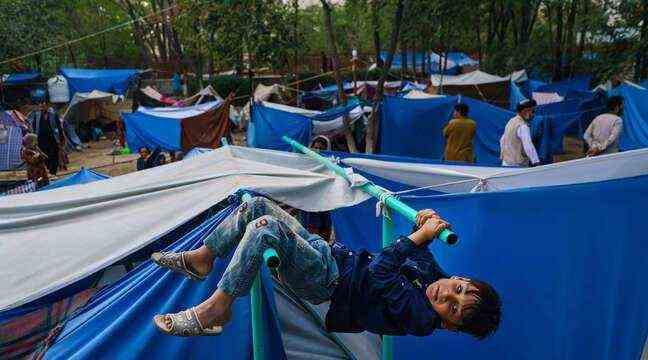Since the conquest of Afghanistan by the Taliban and the controversial declaration by Emmanuel Macron on the need for France to “protect itself against irregular migratory flows”, the question of the reception of exiled Afghans has dominated the political debate. national.
Guests respectively from Europe 1 and LCI, Wednesday August 18, Stanislas Guérini, General Delegate of La République en Marche (LREM) and Laurent Jacobelli, spokesperson for the National Rally (RN), thus advanced similar figures on the subject .
Stanislas Guerini: “Every year, 10,000 Afghans apply for asylum in our country. More than 9 out of 10 obtain asylum and refugee status. It is the honor of our country to do this” pic.twitter.com/Ps0ZIXEKBF
– Europe 1 🎧🌍📻 (@ Europe1) August 18, 2021
“Every year, 10,000 Afghans seek asylum in our country. More than 9 out of 10 obtain asylum and refugee status ”, argued the first, when the second
affirmed : “There are already 10,000 Afghan refugees per year who seek political asylum in France, 4 / 5ths obtain it”.
FAKE OFF
Joined by 20 minutes, the entourage of Stanislas Guérini indicates that the latter was based on “the figures of asylum requests after examination by the Ofpra (French Office for the protection of refugees and stateless persons) then by the Cnda (National Court of ‘asylum) ”, while Laurent Jacobelli mentions as sources, in addition to a
Ofpra press release, an article from “L’Opinion”
dated July 9 titled “France accepts four out of five Afghan refugees”.
Contacted by 20 minutes, Ofpra indicates that “the figures announced are exact. “” In 2020, around 10,000 Afghan nationals applied for asylum. More than 90% of them have obtained international protection, recognized by Ofpra or after appeal to the National Court of Asylum, “adds the organization, while specifying that” the rate of international protection communicated is the one for the first half of 2021 ”, this figure not yet having been published on its site.
Solenne Lecomte, in charge of the Asile coordination in Ile-de-France within La Cimade, an association of aid to migrants, qualifies these statistics, however: “The problem is that it is complicated to have the figures of total Afghan claimants protected in 2020 with official reports. The net percentage of Afghan asylum seekers admitted by Ofpra is around 64% and that of the CNDA around
by 81% agreements on appeals against some of the negative decisions of Ofpra. There were around 2,700 appeals from Afghan applicants in 2020, but the percentage of around 81% applies only to decisions rendered in 2020, the appeals of which could be lodged in 2019. ”
Figures “to be taken with a grain of salt”
The ratio between asylum applications from Afghan citizens and obtaining international protection is in fact less than 90% in Ofpra’s activity report relating to the year 2020. According to pages 108 and 109 of this document, out of a total of 10,364 Afghan applications, the total of “Ofpra and Cnda admissions” thus amounts to 7,494, or 72.3% of requests.
A higher percentage than that of year 2019 (61.3% with 6,244 Ofpra and Cnda admissions out of 10,175 requests, according to pages 102 and 103 of the activity report), due in particular to the Covid-19 crisis, “which has sharply reduced international travel and permanently affected [les] Ofpra’s conditions of activity ”,
which represented a decrease of 28% asylum applications compared to 2019.
” The [chiffres avancés le 18 août] must therefore be taken with a grain of salt, even if it is clear that Afghan applicants are generally recognized as being in need of asylum protection ”, adds Solenne Lecomte, who provides an important clarification:“ Most Afghan applicants (57%) obtain subsidiary protection due to an armed conflict – stable figures, which were already found in 2019 -, against only 7% who are protected by the Geneva Convention thanks to the
refugee status under persecution for political opinions. “
Subsidiary protection less guarantee of stability than refugee status
“The difference is important since conventional refugee protection guarantees protection over 10 years against a 4-year residence permit for subsidiary protection, which can also be reassessed according to the situation in the country. It is much less protective in terms of stability: now that the Taliban are in power, we could consider that it is no longer a question of a generalized conflict but of a situation which is stabilizing ”, explains the specialist of La Cimade. .
Solenne Lecomte further recalls that the “reception conditions for Afghan asylum seekers” are far from “favorable”: “They are often rather young and lonely men, […] forced to live on the street, because they do not have priority in undersized accommodation systems. In addition, many of them are deprived of material reception conditions (accommodation, allowance and administrative and legal follow-up) due in particular to their Dublin background. [le fait d’avoir enregistré leur demande d’asile au préalable dans un autre pays européen que la France] “.

